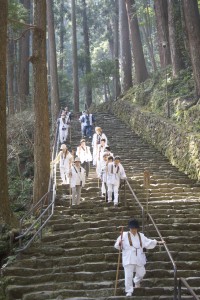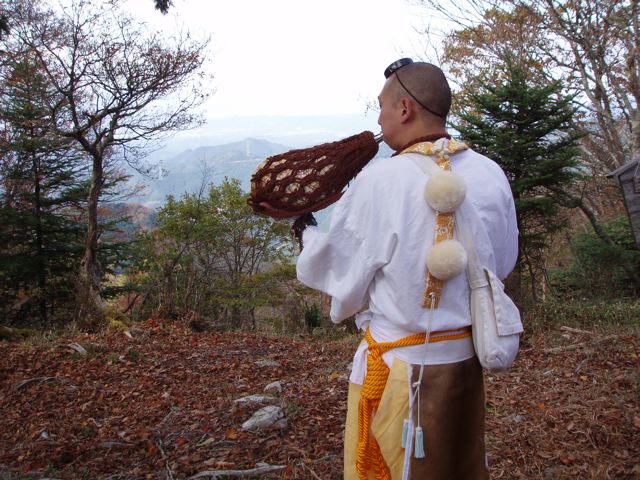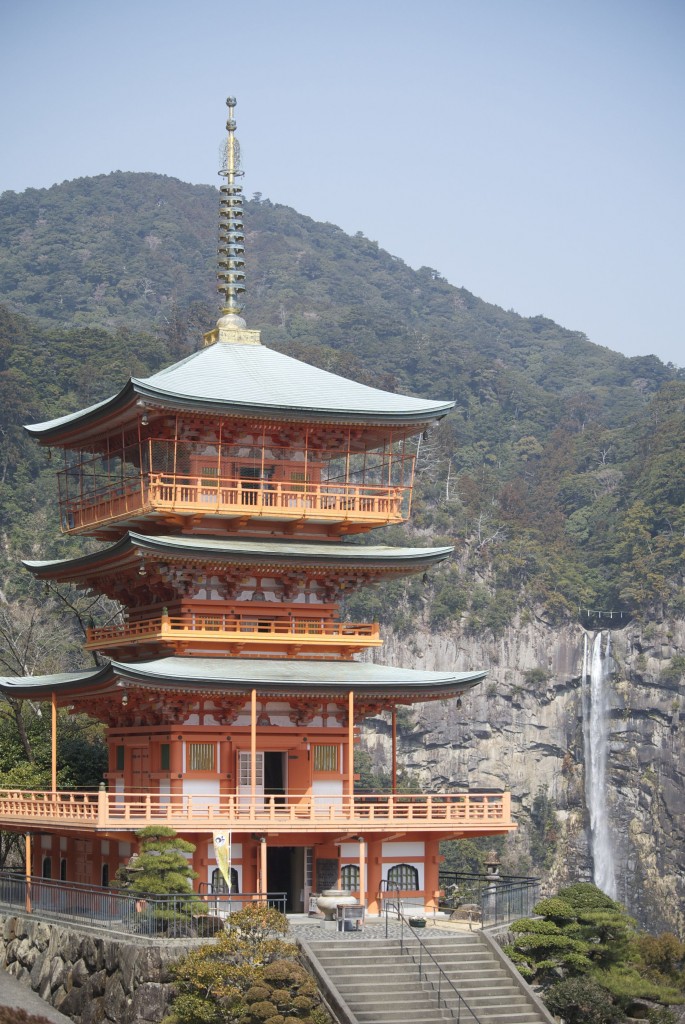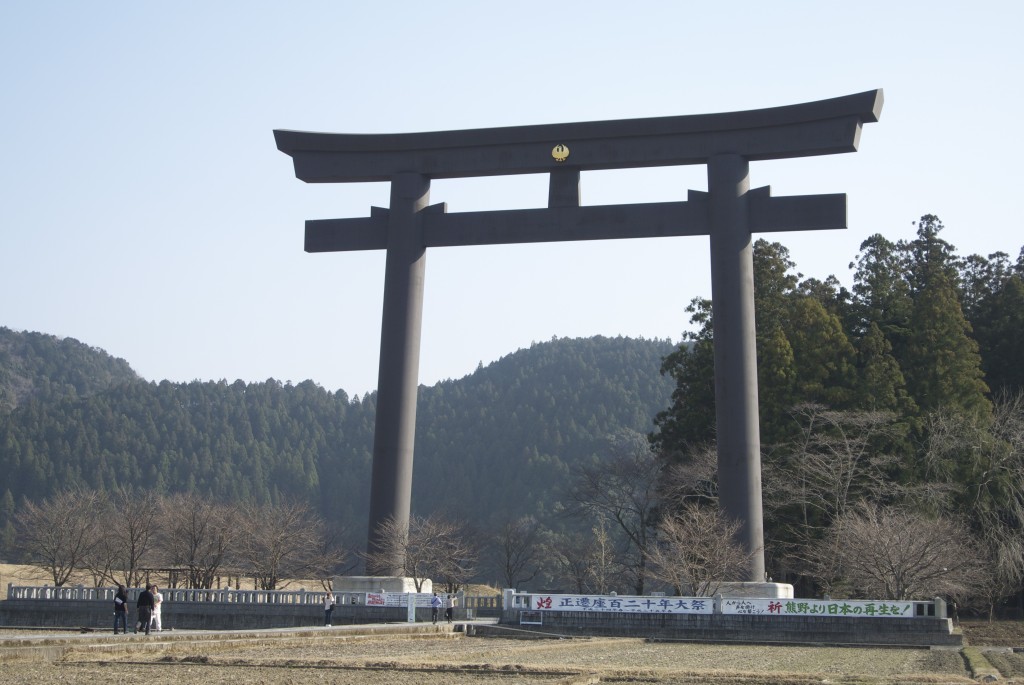There are areas of Japan with a numinous quality, where the veil between this world and the sacred is at its thinnest. One is Izumo; another is Kumano. On opposite sides of Honshu, the two regions are nonetheless linked in a mysterious way and both lay claim to being the site of Yomi, where Izanami was buried.

Pilgrims along the Kumano Kodo
If Ise represents light and sunshine, Izumo and Kumano are the lands of darkness. Ise is imperial-oriented, heavily subsidised by Jinja Honcho, and allied with the ruling élite. Izumo and Kumano are are characterised by myth, folklore and tradition. They offer an alternative to the Meiji-imposed mainstream, as suggested by the reference to the rebel Kumagusu in the article below.
For Green Shinto, Kumano and Izumo epitomise grass-roots spirituality and the religion of the common folk. If the emperor system had been abolished at the end of WW2, as most of the world wished, Ise would have suffered a loss of prestige but the vital flow of age-old beliefs would have continued unhampered in the two ancient realms.
**************************************************************************
SIMON BARTZ in the Japan Times [The below is an edited excerpt of the first of two parts.]
“Once you cross Tonda River, you’re entering the Land of the Dead,” says Brad, a tousle-haired, bespectacled, Japan-loving walking encyclopedia from Canada and also our chief guide on this venture into Kumano — the spiritual heartland of Japan, located on the Kii Peninsula, Wakayama Prefecture.
Land of the Dead? Mordor-like or Mordor-lite? I’m decidedly not scared at this point, but . . . that’s down to naivety. I will almost die, and fall in love in the process.
Me, Brad, a few of his colleagues, and a squad of all-male, all-gaijin (Western) journalists are standing beside the Takijiri-oji Shrine, which most hikers use as a starting point to trek through Kumano, and Brad is spinning a mythical tale, which goes something like this: The female creator deity Izanami died giving birth to the fire deity, so she went to Kumano, the Land of the Dead. Her hubbie, Izanagi, the male creator deity, sought her out. But after seeing her corpse, he was naturally upset and fled the Land of the Dead and jumped into the Tonda River, which runs in the valley below. There he did the misogi (purification ritual) and when he washed his body deities were born. And life, the universe and everything moved on . . .

Yamabushi blowing his horn in Kumano
This is just one of many myths; Kumano has thousands of years of complex religious beliefs involving Shintoism, Buddhism and other obscure belief systems (this place also attracts yamabushi [mountain ascetics], who dangle off cliffs and sit naked under freezing waterfalls).
“The important thing to remember is that Kumano is open to everyone,” says Brad. “This place goes to the core of spirituality rather than holding fast to any specific doctrine.”
As our bus winds up and down through the cedar- and cypress-clad mountains, Brad, a crucial cog in the Tanabe City Kumano Tourism Bureau, says, “This reminds me of Nepal. You climb up and down mountains and then enter a river-valley community where you find lodgings for the night and then continue hiking the next day. That’s the general idea when you visit this area.”
Looking out at the mountains, I get my first “hit” of what this is all about. It feels good. Another guide, Akagi-san, (clad in a traditional yamabushi costume, and fondly nicknamed “Bakagi-san,” blows his horagai (conch trumpet), which is used to attract the attention of the deities and also to communicate.

Nachi's syncretic mix of Buddhism and animism
Pilgrims — from emperors to peasants — have endured a 40-day return hike to Kumano from the ancient capital of Kyoto for thousands of years. Their goal: to visit the Kumano Sanzan, or the Three Grand Shrines of Kumano — Kumano Hongu Taisha, Kumano Nachi Taisha and Kumano Hayatama Taisha.
They would follow a network of routes called the Kumano Kodo, with the most common being the trail following the coast to the town of Tanabe and then turning east on the Nakahechi Route that cuts through the mountains. Brad says that tomorrow we will hike along part of that route — moving through the Land of the Dead.
Next we stop to drink water from the Nonka No Shimizu spring and gaze in awe at the huge Ipposugi cedar tree, with all of its branches pointing south. “That’s because there’s a lot of spiritual power in that direction,” says Brad. [South was associated with Kannon, and as Kumano was the southernmost area of Honshu, the citizens of Kyoto viewed it as sacred land.]
Ipposugi is one of many trees that were saved by the avant-garde environmentalist Minakata Kumagusu. The microbiologist with a fondness for folklore would scamper naked in the woods and then return to a village and tell people that a tengu (long-nosed goblin) had led him to a new species of fungi. He was a fierce opponent of the Meiji Restoration authorities who, in their effort to split Buddhism and Shintoism, were intent on destroying many of the holy areas that fuse the beliefs in Kumano. Kumagusu even got jailed for his dedication to the rebel cause, but in his cell the gods shined upon him, and he found yet another new species of slime mold growing on the wall.
Brad says: “When the government inspectors arrived to check the area to see what had to be destroyed, Kumagusu would be a kind of ‘guerrilla’ guide: One of his famous tricks was to take them to a local inn and get them hopelessly drunk so they’d just pass out and then return to the city with a hangover the next day without destroying anything.”
When I take in the magnitude of silence and peace in this lush valley, I realize this is the “land of living,” and that Tokyo, where I live, is the “land of the dead.” Rather an array of trees than an army of sad-faced salarymen. I get my second “hit,” and it’s a big one.

Torii marking the original site of Kumano Hongu, end point for pilgrimages and now candidate for Japan's largest torii (33.9 meters tall and 42 meters wide)

Leave a Reply